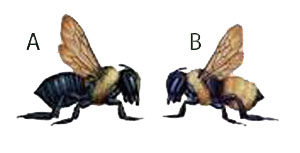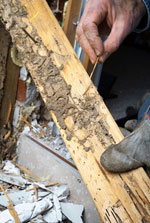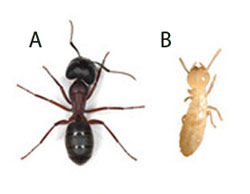Written by: Michael F. Potter and G. Mark Beavers
Subterranean Termites
Subterranean termites are so named because their colonies usually are located belowground with the workers attacking wood above ground. Termites cause billions of dollars in damage and control costs each year. They primarily feed on the cellulose and lignin found in plant cell walls. Bacteria and protozoa that live in the intestinal tract of these insects help to digest these materials.
Termites are social insects that live in colonies in which there is a division of labor between different types of individuals (castes): winged reproductive queens and males, workers, and soldiers.

Termite castes (www.unitedsprayingservice.com)
"Swarmers", the winged reproductives, emerge from the colony between March and June. After mating and finding a suitable site, the queen's wings break off and she begins to lay eggs from which workers will hatch.
The white, soft-bodied workers are the largest group in a colony. Some construct the tunnels and galleries needed for colony growth and clean and maintain them. They use bits of soil and excrement to build shelter tubes and to close breaks in the surface of infested wood. Other workers gather food and water.
Soldier termites have large heads with powerful jaws. They guard the nest from attack by ants and other invaders. Soldiers must be fed and groomed by workers.
Signs of infestation include:
- emerging "swarmers" in the spring,
- earthen (mud) tubes extending over foundation walls, support piers, sill plates, floor joists, etc.
The mud tubes are typically about the diameter of a pencil, but sometimes can be thicker. Termites construct these tubes for shelter as they travel between their underground colonies and the structure. To help determine if an infestation is active, the tubes may be broken open and checked for the presence of small, creamy-white worker termites.
A vacant tube does not necessarily mean that the infestation is inactive; termites often abandon sections of tube while foraging elsewhere in a structure.
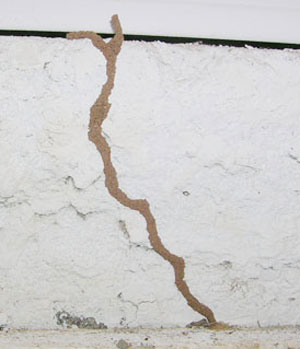
Mud tube (www.greenninjapestcontrol.com)
Termite-damaged wood is usually hollowed out along the grain, with bits of dried mud or soil lining the feeding galleries. Wood damaged by moisture or other types of insects (e.g., carpenter ants) will not have this appearance. Occasionally, termites bore tiny holes through plaster or drywall, accompanied by bits of soil around the margin. Rippled or sunken traces behind wall coverings can also be indicative of termites tunneling underneath.
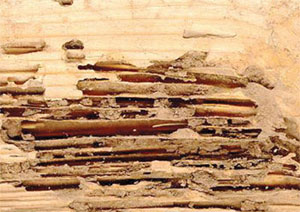
Soil in termite galleries in wood (www.narragansetpestcontrol.com)
Often, there will be no visible indication that the home is infested. Termite infestations can go undetected for years, hidden behind walls, floor coverings, insulation, and other obstructions. Termite feeding and damage can even progress undetected in wood that is exposed because the outer surface is usually left intact.
Termites must have wood for food and usually need soil for moisture. Wood in contact with soil is ideal for termite development. Termites occasionally become established without soil contact when a leaky roof or pipe provides moisture. Infestations may become established under concrete slabs, garage floors, patios, and dirt filled porches. Termites may then enter the building through structural wood or foundation walls adjacent to the slab. In houses built partly or completely on slabs, termites enter through expansion joists, cracks, and utility openings. The presence of a colony can be determined by probing wood near the foundation or soil or by observing earthen “shelter tubes” on foundation walls or wood.
Treatment
Barrier Treatment
For years, the standard method of controlling subterranean termites was to apply a liquid termiticide to the soil. The goal is to create a continuous chemical barrier around and under the building in order to block all potential routes of termite entry. Termites attempting to penetrate the treated soil were either killed or repelled. In actual practice, there are many obstacles to achieving such a barrier. Many potential termite entry points are hidden behind walls, floor coverings, and other obstructions. Even where access for treatment is possible, it is hard to uniformly wet soil and achieve thorough coverage. A typical "barrier" treatment may involve hundreds of gallons of pesticide injected into the ground alongside the foundation, beneath concrete slabs, and within foundation walls.
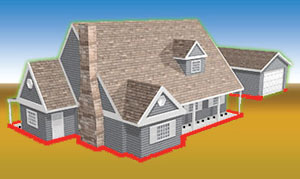
Liquid barrier treatment (www.epestsupply.com)
Trenching
 Trenching (www.epestsupply.com)
Trenching (www.epestsupply.com)
For outside basement walls (where the footing is deep) a V-shaped trench is dug against the wall. It should be deep enough to insure penetration to the footing. After trenching, use a perforated hollow rod to inject insecticide to the footing of the basement wall. When treating concrete block or brick foundation walls, drill them above the grade line and flood all voids with insecticide.
Drilling

Drilling (www.epestsupply.com)
To treat the slab-constructed buildings, saturate the soil beneath the slab. Inject insecticide either through holes drilled in the slab or by drilling and rodding horizontally under the slab. Either method must be done carefully since things such as heat pipes and vapor barriers may be located under the slab. Soil treatment prior to pouring the slab is the best method of prevention.
Treat filled porches by: drilling the slab from the top; drilling the porch foundation horizontally at each end next to the building and injecting the chemical by rodding; or by making openings in the foundation wall, excavating the porch fill immediately under the slab, and drenching the soil with insecticide.
Baits
Termite baiting employs a very different approach. Small amounts of material containing a slow-acting insecticide are placed in stations to knock out populations of termites foraging in and around the structure. Foraging termites consume the bait and share it with their nest mates, resulting in a gradual decline in termite numbers.
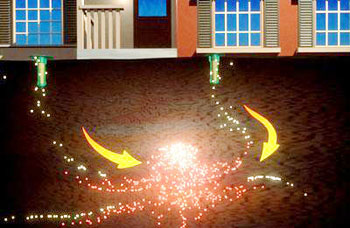
Foraging termite workers find belowground bait stations
(DowAgroSciences)
Some baits may even eradicate entire colonies. A comprehensive baiting program then seeks to maintain a termite-free condition on the customer's property through ongoing inspection, monitoring and re-baiting as needed.
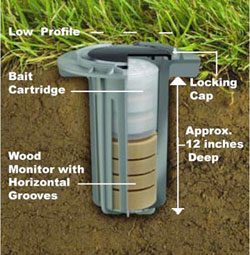 Termite bait station (www.aaaexterminating.com)
Termite bait station (www.aaaexterminating.com)
The baits consist of paper, cardboard, or other palatable food, combined with a slow-acting substance lethal to termites. The bait must be "tasty" enough that termites will readily consume it, even in the presence of competing tree roots, stumps, woodpiles and structural wood. If the bait kills too quickly, sick or dead termites may accumulate in the vicinity of the bait stations, increasing the chance of avoidance by other termites in the area. Delayed-action also enhances transmission of the lethal agent to other termites, including those that never fed on the bait. Entire colonies can be eliminated in this manner, although total colony elimination is not always necessary to afford structural protection. There are different methods of termite baiting. Some are inserted belowground in the yard, while others are installed inside the building in the vicinity of active termite mud tubes. On some properties, baits may constitute the only form of treatment; on others, they may be supplemented with a partial or complete liquid application.
[return]
Carpenter Ants
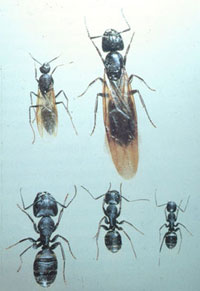
Carpenter ant castes
Winged male, female, and different sized workers (L. Hansen)
Carpenter ants vary in size, measuring up to 1/2-inch long and may range in color from red to black. They prefer to live in moist wood. Their nests are most likely to be found in wood dampened by water leaks around sinks, bathtubs, poorly sealed windows/ door frames, roof leaks, or poorly flashed chimneys. Nests are especially common in moist, hollow spaces such as the wall void behind a dishwasher, or in a hollow porch column. Carpenter ants do not eat wood but simply hollow it out to create galleries to raise their brood. They chew along the grain leaving smooth tunnels that are free of sawdust or soil. Since there often will be no external signs of damage, probing the wood with a screwdriver helps reveal the excavated galleries. Another technique for locating hidden nests is to tap along baseboards and other wood surfaces with the blunt end of a screwdriver, listening for the hollow sound of damaged wood. Structural damage increases with the time a colony is present in a structure.
Carpenter ants feed on protein and sugar. Outdoor food sources can be living and dead insects and the sweet liquid honeydew excreted by aphids and other sap-feeding insects. Indoors, carpenter ants may feed on meats and pet food, as well as syrup, honey, sugar, jelly, and other sweets.
Winged ants can be distinguished from termites by comparing certain features. Ants have a narrow (pinched) waist similar to wasps, while termites are virtually the same width from end to end. Ants and termites each have four wings; however, the front wings of ants are longer than the hind wings. The four wings of termites are equal in size and length. Finally, the antennae of ants are bent or "elbowed"; termite antennae are straight.
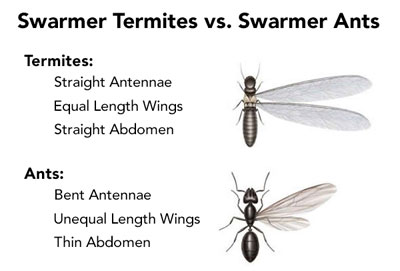
Antennae, waist, and wings of termites and ants are very different. (www.tigertermite.com)
The best method to control carpenter ants is to locate and destroy the nest, replace damaged or decayed wood, and eliminate existing moisture problems. This can be a difficult and challenging task.
[return]
Powderpost Beetles
The name powderpost beetle is used to for several species of small (1/8 to 3/4 inches long) boring insects that reduce wood to a fine, flour-like powder during their development. Damage is done by the grub-like larvae as they chew narrow, winding tunnels in wood.
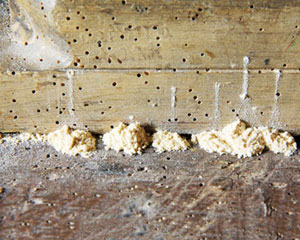 Powderpost beetle "shotholes" and sawdust (townandcountrysolutions.com)
Powderpost beetle "shotholes" and sawdust (townandcountrysolutions.com) Powderpost beetles normally breed in the dead branches and limbs of trees. However, they can attack stored lumber, rafters, joists, finished wood, and furniture products. Infestations usually begin when the beetles lay eggs in wood that is being stored and cured. New adults emerge later from the finished product. Old items of furniture and wood antiques are especially vulnerable to attack by these insects.
Infestations are discovered after noticing small, round "shotholes" in the wood surface. These are exit holes where adult beetles have chewed out of the wood after completing their development. In addition, slight jarring of the wood causes a fine powder to sift from these holes. When the wood is cut or broken, the interior reveals galleries filled with a finely packed powder which is sawdust-like waste produced by the feeding of grub-like larvae. Newly-emerged adults mate and lay eggs on or below the surface of bare (unfinished) wood. The eggs hatch into tiny larvae which bore into the wood, emerging as adults 1-5 years later.
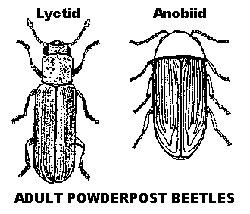
(M.F. Potter, University of Kentucky)
There are several species of powderpost beetles. The most common are Lyctid powderpost beetles and Anobiid powderpost beetles. The adults are small (about 1/3 inch long) and usually reddish-brown to nearly black.
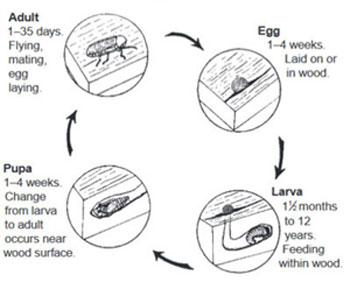
The stages in the life cycle of powderpost beetles are: egg, larva, pupa and adult.
(apolloxpestcontrol.com)
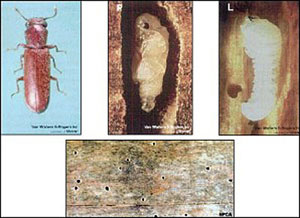 Adult, pupa, larva, and damage of lyctid powderpost beetle (www.peipestcontrol.com)
Adult, pupa, larva, and damage of lyctid powderpost beetle (www.peipestcontrol.com)
Lyctid powderpost beetles attack only products manufactured from hardwoods , e.g., oak, ash, walnut and hickory. Infestations are most often found in wood paneling, molding, window and door frames, plywood, hardwood floors, and furniture.
Imported tropical hardwoods are especially prone to lyctid beetle attack because of poor storage and drying practices prior to shipment to this country. Articles made of bamboo also are commonly infested. Rafters, joists, studs and other structural framing of homes are not normally attacked by lyctid beetles since these wood members are almost always constructed from pine or other softwoods. Lyctids rarely infest wood older than 5 years. Thus, infestations generally are encountered in new homes or newly-manufactured articles. In almost all cases, infestation results from wood that contained eggs or larvae at the time of construction.
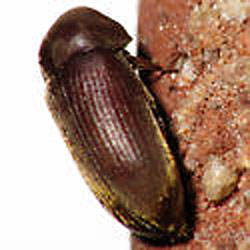 (Bugguide.net, Iowa State University)
(Bugguide.net, Iowa State University)
Anobiid powderpost beetles may attack both hardwoods and softwoods, which means that infestations may be found in all the same places as Lyctid beetles, as well as in structural timbers (beams, sills, joists, studs, subflooring, etc). Maple, beech, poplar and pine are especially susceptible to attack. Anobiids prefer to infest wood which is damp; therefore, infestations usually begin in moist, poorly-ventilated areas such as crawl spaces, basements, garages and utility sheds. Under favorable conditions of moisture and temperature, infestations may spread upwards into walls and upper levels of the structure, including furniture. Infestations may occur as a result of using infested lumber, or from beetles flying in from outdoors or being carried in on firewood. Infestations develop slowly but wood can be re-infested year after year.
To prevent infestation or to control existing infestation, wet all surfaces thoroughly with insecticide. Furniture and other movable objects may be fumigated in special chambers.
Longhorned Beetles
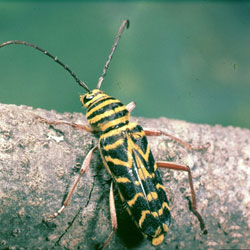
Longhorned beetle adult (Clemson University USDA Cooperative Extension Slide Series, Bugwood.org)
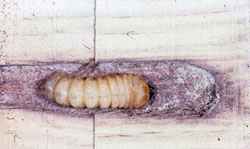
Longhorned beetle larva (Lacy L. Hyche, Auburn University, Bugwood.org)
Longhorned beetles are large (½ to 3 inches long) and brightly colored. They have long, thin antennae which may be longer than the body. Eggs are usually laid on unseasoned, rough-sawed timbers or logs. The larvae, called roundheaded borers, feed in the wood. They bore large, oval holes as they move through the wood. The stages in the life cycle of the long-horned beetle are: egg, larva, pupa, and adult.
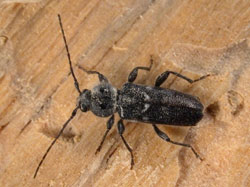
Old house borer adult
(Pest and Diseases Image LIbrary, Bugwood.org)
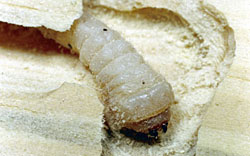
Old house borer larva
(Clemson University USDA Cooperative Extension Slide Series, Bugwood.org)
The only longhorned beetle species that requires control in structures is the old house borer. The adult is about 3/4 inch long, grayish-brown to black, and has two white patches on the wing covers. Its galleries have distinctive ripples on the interior surface. The old house borer usually damages only pine sapwood.
For control of old house borer, infested timbers must be drilled and pressure-treated to force the insecticide throughout the gallery system. Fumigation under a tarpaulin may sometimes be required.
[return]
Carpenter Bees
Carpenter bees resemble bumble bees but the upper surface of their abdomen is bare and shiny black; bumble bees have a hairy abdomen with at least some yellow markings.
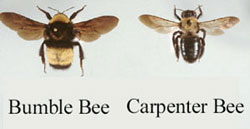
Comparison of bumble bee and carpenter bee
(www.doyourownpestcontrol.com)
Carpenter bees rear their young in tunnels that they chew into weathered softwood. The entrance hole and tunnels are perfectly round and about 1/2-inch in diameter. Coarse sawdust often accumulates beneath the entry hole. Females lay their eggs along it in a series of cells. Each is provisioned with a ball of pollen on which the larvae feed. The new adults emerge in late summer. Female carpenter bees may excavate new tunnels for egglaying, or enlarge and reuse old ones. They may cause extensive damage over time.
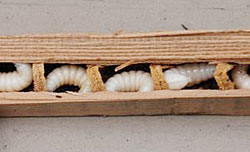
Carpenter bee larvae in galleries
(www.myfavoritegardenshop.com)
[return]
Wood Rot
Cubical brown rot is a type of decay that causes wood to shrink and separate into brown cubes that split against the grain. Advanced stages of brown decay result in dry, powdery wood that cannot support much weight and crumbles easily.
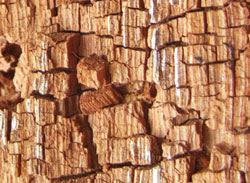
Cubical brown rot (www.basementsystems.com)
White rot is a white, stringy and mushy. It tends to be more common in hardwoods.
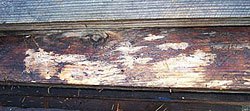
White rot (www.stewartpaint.com)
Severe wood decay occurs only in wood with a moisture content greater than 20%. Most wood-rotting fungi grow only on wood which is subject to wetting by rain, roof leaks, plumbing leaks, condensation, or contact with moist soil. Fungi take their food from the wood as they grow and reduce the strength of wood, often making it brown and crumbly or white and stringy. Discoloration and powdery mold growth below the surface of wood should not be confused with decay although it indicates the surface of the wood has had greater than 20% moisture at one time. The moisture content of the wood may be measured with a moisture meter to accurately determine the need for control.
Fungicides will not stop wood decay once it has started, though they may slow its progress. The key to complete control of wood decay is to eliminate the source of moisture. This may be done through proper drainage, breaking control between wood and soil, proper ventilation, the use of vapor barriers, and waterproofing foundations. In some situations, pressure-treating lumber with preservative chemicals may prevent attack.
The term "dry rot" has been used to describe decayed wood that has since dried and ceased to decay. Moisture is required for wood decay to occur, so no literal “dry rot” exists.
[return]

























